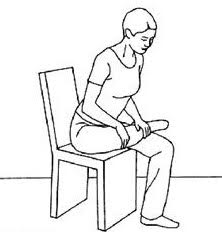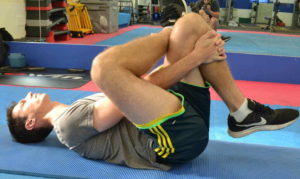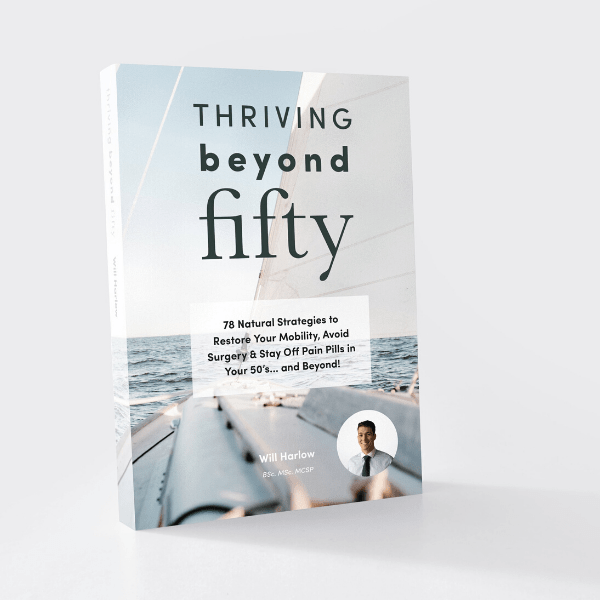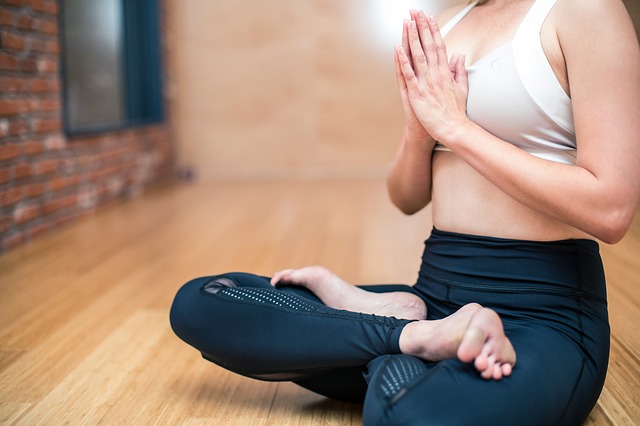While piriformis syndrome may be “over-diagnosed”, it can prove stubborn and troublesome for those unlucky enough to be afflicted with it.
While you may find plenty of online articles and videos with exercises to help piriformis syndrome, many of the exercises you’ll find online for this problem may well make it WORSE.
To our knowledge, there aren’t many clear guidelines on the piriformis syndrome exercises to avoid.
That’s where this article comes in!
Today, we’re going to talk about the top piriformis syndrome exercises to avoid, and which ones may be better instead. We’ll also talk about how to safely exercise when you have piriformis syndrome at the end of the article.
First, for a complete guide on piriformis syndrome, including the right exercises to do, see this article.
If you aren’t sure whether you have piriformis syndrome but you do have persistent buttock pain, try this article instead.
Before we dive in, please be aware that we are part of the Amazon Affiliate programme. This page may contain Amazon affiliate links, so if you choose to purchase a product for your sciatica that we recommend through a link on this page, we will receive a small commission at no extra cost to you. This helps us keep Overcome Sciatica alive! Thank you for your support. Please be assured that we only ever recommend products that we truly believe can help.
The exercises provided on this page for informational purposes only and are not designed to be a ‘prescription’ of any kind. Be sure to check with your healthcare provider before you begin any new exercise programme.
Before we begin, let’s quickly recap what piriformis syndrome is:
The piriformis is a muscle that lies deep within your buttock region and helps to control the hip when you walk. In most people, the sciatic nerve passes right by the piriformis muscle, WITHOUT travelling directly through it (ref).
For these lucky people, piriformis syndrome is very rare.
However, in around 6-25% of the population, the sciatic nerve actually passes THROUGH the piriformis muscle. In these people, when the piriformis contracts or spasms, it can sometimes compress the sciatic nerve, resulting in pain that starts in your buttock and can run all the way down your leg (otherwise known as sciatica).
“Sciatica” just describes the symptom of nerve pain in the leg. So, sciatica is not a “separate condition” to piriformis syndrome. Piriformis syndrome can be one of many causes of sciatica.
Watch the video below for a great explanation about the TRUTH when it comes to piriformis syndrome:
The Problem with Piriformis Syndrome
One of the main problems with this condition is that piriformis syndrome will usually continue to be problematic unless you can successfully avoid doing the things that aggravate it or caused it in the first place.
It should be better communicated that choosing the RIGHT piriformis syndrome exercises is only half the battle in getting better.
Avoiding certain movements, positions and exercises is the lesser known, yet equally important, second half of the battle against piriformis syndrome.
A lot of people struggle with this: They do EVERYTHING they can to relieve their piriformis syndrome pain… But they NEGLECT working out what caused the problem in the first place, and unknowingly continue to do that very thing!
This STOPS piriformis syndrome from getting better… Despite all that effort you’re putting in to treating it.
In this way, because there are many causes of piriformis syndrome – each with a different set of things that need to be avoided to allow healing – there are also many different piriformis syndrome exercises to avoid, depending on what caused the problem in the first place.

The most common underlying causes of piriformis syndrome are the following:
- Prolonged sitting and sciatic nerve irritation as a result
- Weakness in the gluteal muscles causing an over-worked piriformis
- Biomechanical abnormalities (movement problems to do with the hips)
Working Out What Caused Your Piriformis Syndrome
In order to best identify the piriformis syndrome exercises to avoid for your particular circumstances, you need to have some knowledge of what caused your piriformis syndrome in the first place.
It is often possible to make an accurate assumption as to the cause of your piriformis syndrome, based on a few key facts that are relevant to your circumstances.
The biggest key here tends to be your lifestyle. Here are some clues as to what caused YOUR piriformis syndrome:
Piriformis Syndrome For Office Workers
If you spend 8 hours a day sitting in an office, or you count yourself as unfit and possibly overweight… chances are that your sitting has contributed to the development of piriformis syndrome.

Spending prolonged periods of time sat down can cause a chronic compression on the sciatic nerve, in the area where it passes under the piriformis muscle.
Once aggravated, the sciatic nerve and piriformis muscle can remain inflamed and tender for a long period of time unless the correct measures are taken to relieve that pressure.
An inflamed and tender piriformis muscle over the long term can lead to piriformis syndrome.
Piriformis Syndrome For Those Who Don’t Sit for Long Periods
If you don’t sit for long periods of time but have developed piriformis syndrome, it isn’t likely that direct compression from sitting is the cause.
For most people in this situation, the underlying cause of their piriformis syndrome tends to be MECHANICAL – which means weakness or tightness in certain muscle groups.
The most common presentation is weakness in the gluteals (a set of muscles that make up your buttocks).
The muscles in the buttocks all work together as a team to stabilise the pelvis and allow movement when walking. When one muscle group becomes lazy, others have to pick up the slack.
This is often what causes a tight piriformis – the gluteals have become weak and the piriformis is having to do extra work, causing it to become fatigued, overworked and tight.
When the piriformis has to persistently do work that it is not designed to do, it can lead to tightness over the long term.
To check whether you are at risk, you can test the strength of your gluteals using the following method. Watch the video below and then try it yourself – if you have a “positive Trendelenberg sign”, there’s a good chance that you ARE suffering because of your weak gluteals!
A fatigued and overworked piriformis can become tight and lose its strength capacity. When this happens, it can cause piriformis syndrome.
Gluteal weakness as the cause of a piriformis syndrome problem is more common in women than men, and is more common in those who are unfit, overweight or out of shape.
Piriformis Syndrome For Runners and Athletes
While the last two causes of piriformis syndrome are more prominent in the less fitness-focused population, piriformis syndrome also plagues runners and other endurance athletes.
So, why is that?

The answer is that it usually comes down to problems with their running (or cycling) styles and movement patterns.
Similar to the cases above, when a particular running style leads to the overuse of one muscle group, an imbalance occurs. This leads to tightness in one group of muscles and weakness in others.
Let’s talk about the gluteals again.
If the gluteals are weak in a runner, the piriformis must then pick up the slack to stabilise the pelvis during each stride. This can lead to a tight piriformis which compresses the sciatic nerve.
So, What Are the Piriformis Syndrome Exercises to Avoid for Each of These Groups of People?
To determine the piriformis syndrome exercises to avoid, we must split our piriformis syndrome sufferers into three groups, based on what caused their problem in the first place.
For Office Workers
As sitting caused your problem, the main piriformis syndrome exercises to avoid are any which involve sitting.
If you have been given movements to do in a chair, like crossing your leg over the other to stretch the buttock, you might want to consider replacing this exercise with a similar version while lying on the floor.


You can see a video demonstration of this exercise here:
You may also want to consider using a ring cushion to sit on when you are at work.
This can alleviate pressure from the affected buttock and significantly improve your comfort at work. What’s more, you’ll be maximizing the chances of your piriformis syndrome recovering quicker by avoiding the number one aggravation for your problem – pressure on the affected area.
Here is a fantastic option that I’ve recommended to clients before to great success:
Supportiback® | The #1 Donut Seating Cushion

This gel cushion allows excellent comfort at work while relieving the pressure on your piriformis. It is discrete and portable, making it a great choice for the office.
Click HERE to view the product on Amazon UK
Click HERE to view the product on Amazon.com
So, in summary, if your piriformis syndrome was caused by sitting, any exercise that involves sitting is an exercise that is likely to irritate the piriformis, and should be avoided.
Can Stretching Make Piriformis Worse?
Yes, absolutely! Not everyone should be stretching their piriformis muscle.
The general consensus should be to only persist with the stretching if it feels comfortable and like it is causing a “stretching” sensation rather than a “burning pain” sensation.
We talk more about this below.
For Those Who DON’T Sit for Long Periods
The piriformis syndrome exercises to avoid for those who don’t sit for prolonged periods include any which aggravate your symptoms while you are doing them.
For example, for many people, stretching the painful buttock or piriformis actually makes their symptoms WORSE, not better.
I see lots of people come into my clinic who have been stretching the hell out of that poor piriformis muscle… Only to make the problem worse.
If this sounds like what you’re going through right now, STOP stretching that piriformis muscle!
For some people, relentless stretching can make the problem 10 times worse.
My international sciatica specialist colleague, Dean Volk, is a long-time advocate for STOPPING stretching painful piriformis muscles in favour of something much more effective.
I can proudly recommend Dean and his course for sciatica sufferers – because I’ve seen his incredible results first-hand. You can check out his course (and get lifetime access to the videos and bonus content) by clicking HERE.

Check out Dean Volk’s “Kicking Sciatica OUT of the Butt!” Online Pain Relief Course Here!
Not Just Stretching
It isn’t just stretching that can aggravate piriformis syndrome. There are some strengthening movements too, which are commonly prescribed yet often make the problem worse.
One of the piriformis syndrome exercises to avoid for many people is “The Clam” exercise, despite it being very commonly prescribed for this issue.
The reason I recommend avoiding “The Clam” for many of my clients is because it involves external rotation of the hip – a movement that the piriformis is directly responsible for.
Your piriformis is ALREADY severely over-worked.
Why would we want to punish it even more than we are already?
For some people, this exercise can work – however, if you’re like many others, it can actually make the problem worse.
The only way is to test – if you try this exercise and feel worse after, certainly avoid it.
It is best to strengthen the muscles around the piriformis (rather than the piriformis itself) to allow them to take some pressure off the poor over-worked piriformis.
This can be tough to do and often takes professional guidance. Again, check out Dean’s course here to be shown how.
Even for people who don’t get a bad reaction, “The Clam” is much less effective when compared to the next exercise that I suggest below…
What to Do Instead
For people in this group, the priority should be strengthening the GLUTEAL muscles in the painful buttock.
While there are hundreds of exercises to choose from to achieve this goal, you only really need one carefully selected exercise to get a good result.
The video below shows exactly what I often recommend for strengthening the gluteals and taking some pressure off that overworked piriformis:
It may take a fairly long time to correct a muscle imbalance like this – we’re talking at least 2-3 months – but the results should be long-lasting (and should also provide relief from knee pain and other hip problems too).
The above exercise has been shown to be the exercise that elicits the most gluteal activation out of all the different glute exercises tested (ref).
Other Ways to Find Relief
Another option is to find pain relief through the use of a TENS machine.
TENS machines are small electrical units that pass a current through a muscle and stimulate it to release positive endorphins and allow the muscle to relax.
Below are two great options for sciatica pain relief:
#1 – TENSCare Perfect TENS Pain Relief Machine

This TENS machine for sciatica has 8 preset programs so you don’t need to “tune it” yourself – just pick a setting and off you go! There is an option to purchase a ‘Value Pack’ which includes spare pads which I would definitely recommend.
Click HERE to view the TENSCare Perfect TENS Pain Relief Machine
Click HERE to view the TENSCare Perfect TENS Pain Relief Machine on Amazon US (closest match)
#2 – TPN 200 Plus TENS Machine

A super-simple yet sleek design, this TENS machine is perfect for those who want a highly effective model and are confident with using a TENS machine for sciatica pain relief. This unit doesn’t have a fancy display, so you can customize the settings to best suit your needs, tweaking and changing the frequency until you find one that works best for you.
Click HERE to view the TPN 200 Plus TENS Machine
Click HERE to view the TPN 200 Plus TENS Machine on Amazon US (closest match)
Thinking of buying a TENS machine for sciatica relief? Click HERE to view our top 10 TENS machines for sciatica in 2021.
Piriformis Syndrome For Runners and Athletes
Runners and athletes will probably also benefit from the strengthening exercise above, but more advanced athletes may be better assessed by a professional who can work out the muscle imbalances causing your particular problem.
In athletes, muscle imbalances can be very subtle, but because their activity is usually repetitive and performed over a long time, the repetition brings out problems over the long-term if left unchecked.
What Are the Other Piriformis Syndrome Exercises to Avoid?
A note of caution: From my experience, runners and athletes LOVE to “release” muscles and “trigger point” painful areas!
For this reason, the piriformis syndrome exercises to avoid for runners and athletes are heavy foam rolling and intense stretching of the piriformis.
Here’s why:
When you insist on pummeling a tight piriformis with a foam roller or even a golf ball, if you are too rough then it can cause the muscle to tighten up even further.
This video below is a great example of a method that is likely to IRRITATE a piriformis and could make your symptoms WORSE:
What’s more, where the sciatic nerve sits in the buttock is actually quite close to the surface of your skin.
If you pummel and massage that area, you risk directly irritating the sciatic nerve even further, leading to worse symptoms than before.
The same is true of stretching. When you aggressively stretch a painful area, you often increase the compression on the nerve and worsen your symptoms.
A great – yet hardly known – alternative is to try stretching the opposite leg instead, gently releasing any tension on your non-painful leg.
Watch the video below, where I demonstrate one option for effectively stretching for sciatica relief – this video is equally applicable to piriformis syndrome:
I know that it may FEEL like the tight buttock needs a good stretch to relieve it, but most people are far better off going gently, stretching the opposite leg only, and opting for strengthening exercises instead in most instances.
If you found this exercise useful, you’ll find many more with a similar goal in Dean’s Sciatica & Piriformis Syndrome Relief programme.
Should You Exercise with Piriformis Syndrome?
As different people find different forms of exercise either aggravate or relieve their piriformis syndrome, I can never give an accurate, one-size-fits-all answer for how to go about exercising with piriformis syndrome.
However, for many athletes, there will have been a certain type of exercise that CAUSED the problem in the first place, or at least contributed to it.
For example, if you are a runner and you started to slowly develop piriformis syndrome, it makes sense to cut back on running when exercising with piriformis syndrome.
For this athlete, I might recommend temporarily swimming or using the cross-trainer instead.
Similarly, for a cyclist, sometimes just taking the pressure OFF the piriformis by getting out of the saddle for a while can help to relieve piriformis syndrome pain after a period of rest.
For non-athletes, exercising with piriformis syndrome is important.
Most people should continue to walk and do usual activities as much as possible, as long as it doesn’t aggravate their problem and they haven’t been told not to by a healthcare provider.
Just be sure to listen to what your buttock and leg are telling you! If they are crying out in pain and asking you to stop, don’t continue to push through with your exercise routine out of sheer stubbornness.
Is Walking Good for Piriformis Syndrome?
Generally, the answer is yes – but if walking is aggravating your symptoms, either cut down on distance or pace, or take regular breaks.
However, generally walking is good for piriformis syndrome as long as it is well tolerated.
We talk more about pacing strategies, when to keep walking and when to stop, and all manner of things health related in my book, Thriving Beyond Fifty, which you can see below:
Top Tip: Grab a copy of my #1 Best-Selling book, Thriving Beyond Fifty for more health, wellness and recovery strategies!

piriformis syndrome exercises to avoid: Summary
I hope my reasoning behind the piriformis syndrome exercises to avoid has made sense for you today!
It can be extremely confusing trying to choose the right exercises for piriformis syndrome and sciatica in general, so if you are still seeking guidance about which exercises to avoid when you have piriformis syndrome (and what to do instead), check out the course below:
Are You Looking for RAPID Relief from Sciatica?
My good friend, colleague and fellow international sciatica expert, Dean Volk, has a brand new sciatica relief video course available – and I’m delighted to be an official sponsor!

Check out Dean Volk’s “Kicking Sciatica OUT of the Butt!” Online Pain Relief Course Here!
I can proudly recommend Dean and his course for sciatica sufferers – because I’ve seen his incredible results first-hand. You can check out his course (and get lifetime access to the videos and bonus content) by clicking HERE.
The information on Overcome Sciatica should never be used as a substitute for medical advice from a doctor. Never put into action any tips or techniques from Overcome Sciatica without checking with your doctor first. Please see full terms of use here.
As always, thanks for reading.


Excellent guide on what exercises to do for Piriformis syndrome. I’m one of a small percentage that actually suffers with it. It’s great to know there is someone who wants to help people get control of their lives back.
Very helpful indeed. I have been in a lot of pain and am already much more comfortable. Many thanks.
I am so confused!! Please help!! I am a runner, who started a (part time) desk job almost 2 months ago. (Now have a special cushion!) I have seeked very good professional physio treatment twice. What I have had done to me and what I have been advised contradicts a lot on here. (I do have piriformis syndrome.) And because I am a runner and new to sitting at a desk again, I come in two of the categories listed. I’ve been told to stretch it, I’ve been told to sit on a ball, I’ve had it prodded and worked on very hard today… When I try to run (over the past 2 weeks) every other day, I’ve ran no more than 2 miles, normally 1.5 miles in, behind my left knee it starts to explode. (Sciatic nerve I believe.)
So do I stretch and work on this left side of piriformis muscle or not?! Do I work on the other leg? Should I do some squats? Leg raises? Should I leave it alone? Should I not try and run for a long time? It’s so hard knowing what to do for the best and what not, when I get and see and read so much conflicting info :(( Please help if you can. Thank you
Thank you for this, it makes a lot of sense to me. My massage therapist suggested clam, and crab walk. The clam hurts when I do it so I have avoided. Will try the side lying exercise instead.
Thank you for this detailed and considerate guide in navigating life with PS.